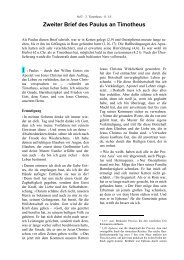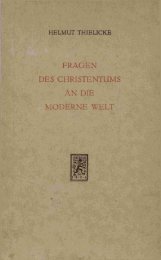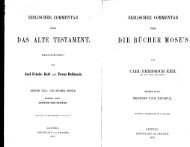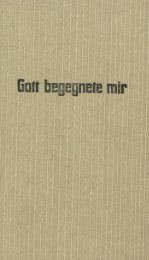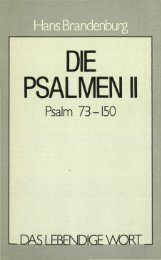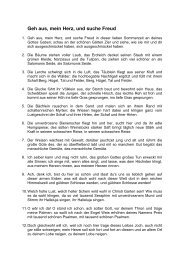You also want an ePaper? Increase the reach of your titles
YUMPU automatically turns print PDFs into web optimized ePapers that Google loves.
Malleus<br />
Head<br />
Long (lateral)<br />
process<br />
Short<br />
process<br />
Handle<br />
of malleus<br />
Incus<br />
Body<br />
Short process<br />
Long process<br />
Base of stapes<br />
Temporal muscle<br />
Temporal bone<br />
Stapes<br />
Incus<br />
Malleus<br />
Ear drum<br />
Lateral semicircular duct<br />
Posterior semicircular duct<br />
Anterior semicircular duct<br />
Base of stapes<br />
Oval window<br />
Vestibule<br />
Round window<br />
Cochlea<br />
Vestibular nerve<br />
Vestibular ganglion<br />
Cochlear nerve<br />
square metre). But in acoustics, another unit is<br />
preferred, called sound level or noise level, which<br />
is measured in dB (deciBels). To convert sound<br />
pressure p x into the corresponding dB number,<br />
we use the quotient p x /p 0 where p 0 = 2 x 10 -5 N/m 2<br />
represents an arbitrarily selected reference value.<br />
It is actually the pressure of a sound which one<br />
can just detect at the threshold of audibility. The<br />
logarithm (base 10) of the ratio p x /p 0 is multiplied<br />
by 20 so that the formula for the noise level L<br />
in dB is<br />
L = 20 x log(p x /p 0 ).<br />
This seemingly random definition has a number<br />
of advantages:<br />
Auricle<br />
External acoustic<br />
meatus<br />
Eustachian tube<br />
Apex of the cochlea<br />
Cochlear duct<br />
Structure of the human ear.<br />
Sound vibrations travel through the external acoustic<br />
meatus to the ear drum, and then via the malleus, the<br />
incus, and the stapes through the oval window into the<br />
liquid-filled cochlea. The round window allows the pressure<br />
between the cochlea and the air-filled middle ear to<br />
be equalised. The three arc-shaped structures (semi-circular<br />
ducts) are part of the organ of balance. Sounds are<br />
detected in the two spirals of the cochlea which contain<br />
the organ of Corti. This has some 15,000 sensory “hair”<br />
cells. A thick “cable” of nerve fibres (the cochlear branch<br />
of the 8 th cranial nerve), leads from the cochlea to the<br />
brain.<br />
the number of vibrations per time unit increases<br />
(shorter wave length), we hear a higher pitched<br />
sound. The pitch of a tone – its frequency – is<br />
measured in Hertz (1 Hz = one vibration per second).<br />
If the amplitude increases, the sound<br />
becomes louder, and a decrease in amplitude<br />
results in a softer sound. Everyday sounds comprise<br />
a mixture of different frequencies and<br />
amplitudes.<br />
– Instead of using cumbersome powers of ten<br />
for pressure, these values are expressed by<br />
one, two or three digit numbers.<br />
– The following simple relations hold for the<br />
indicated physical units:<br />
– A tenfold increase in sound pressure is<br />
expressed as a change of 20 dB.<br />
– If the sound pressure is doubled, we have an<br />
increase of 20 x log(2) = 20 x 0.30103 = 6 dB.<br />
– In the case of a three-fold increase in sound<br />
pressure the formula produces a dB change<br />
of 9.54, which can be rounded off to 10 dB.<br />
– The energy level of a sound is proportional to<br />
the square of the sound pressure, meaning<br />
that when the energy is doubled, the decibel<br />
level is increased by 3 dB.<br />
Loudness: The noise level of a sound is a purely<br />
physical measure, expressed in either N/m 2 or dB.<br />
But this gives no indication of the subjective<br />
experience of the loudness of a sound. Sound<br />
The amplitude of a sound is called sound pressure,<br />
which, in the same way as any other type of<br />
pressure, can be measured in N/m 2 (Newtons per<br />
22




